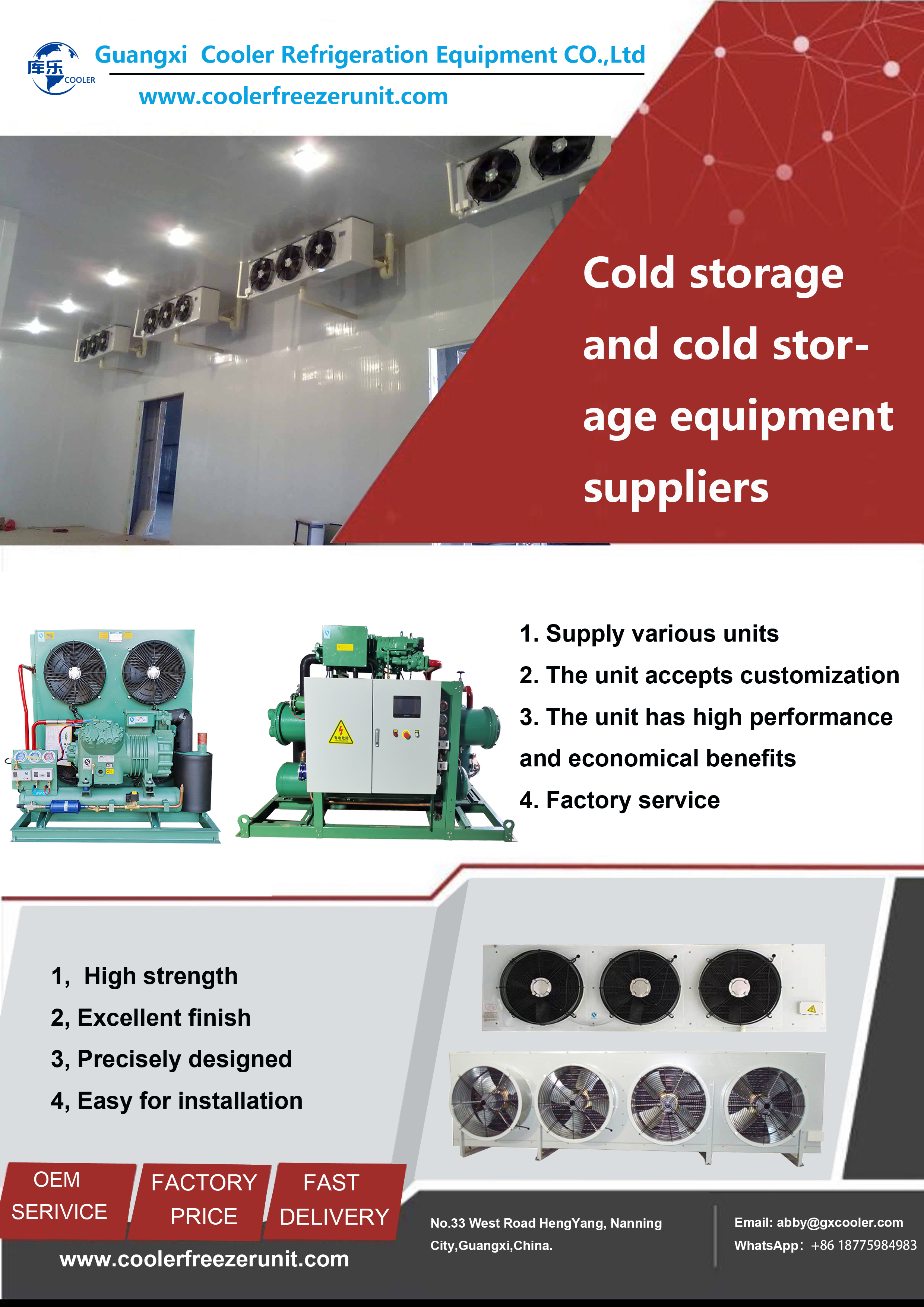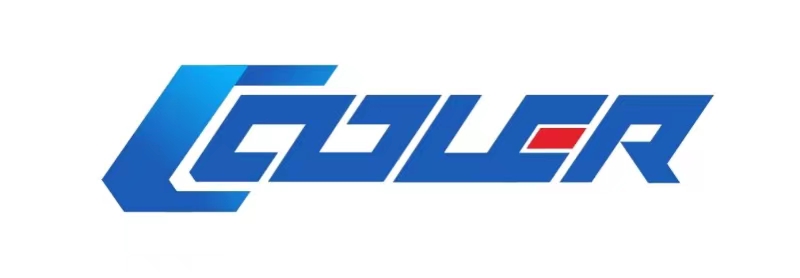1.Cold Storage Kapasiti penyejukan dikira
Kapasiti penyejukan sejuk storan sejuk boleh mengira penggunaan penyejukan storan sejuk, dan syarat paling asas yang perlu disediakan:
produk
Saiz simpanan sejuk (panjang * lebar * tinggi)
Kapasiti simpanan sejuk
Jumlah pembelian: T/D
Masa penyejukan: jam
Suhu masuk, °C;
suhu keluar, °C.
Mengikut pengalaman, mengikut saiz storan sejuk, ia dibahagikan kepada dua situasi:
Anggaran beban penyejukan storan sejuk kecil (di bawah 400m3).
Anggaran beban penyejukan storan sejuk yang besar (melebihi 400m3).
Anggaran beban penyejukan storan sejuk kecil (di bawah 400m3):
Suhu penyimpanan melebihi 0℃, suhu penyejatan -10℃, 50~120W/m3;
Suhu penyimpanan -18℃, suhu penyejatan -28℃, 50~110W/m3;
Suhu penyimpanan -25℃, suhu penyejatan -33℃, 50~100W/m3;
Suhu penyimpanan ialah -35°C, suhu penyejatan ialah -43°C, 1 tan menempati kawasan seluas 7m2, dan penggunaan penyejukan ialah 5KW/tan*hari; lebih kecil storan sejuk, lebih besar penggunaan penyejukan per unit isipadu.
Anggaran beban penyejukan storan sejuk yang besar (melebihi 400m3):
Terdapat dua sampel untuk rujukan anda:
Suhu penyimpanan 0~4℃, suhu penyejatan -10℃
Secara lalai parameter berikut:
Nama barang: buah-buahan dan sayur-sayuran;
Kapasiti simpanan (tan): 0.3*0.55*isipadu storan m3;
Jumlah pembelian 8%;
Masa penyejukan 24 jam;
Suhu masuk: 25 ℃;
Suhu penghantaran: 2 ℃.
Dalam parameter lalai, beban mekanikal gudang suhu sederhana: 25 ~ 40W/m3; konfigurasi biasa: 4 bilik sejuk; Unit selari 90HP dengan gudang suhu sederhana 1000㎡*4.5m tinggi.
·
Suhu penyejukan -18 ℃, suhu penyejatan -28 ℃
Secara lalai parameter berikut:
Nama barang: daging beku;
Kapasiti simpanan (tan): 0.4*0.55*isipadu storan m3;
Jumlah pembelian, 5%;
24 jam masa penyejukan;
Suhu masuk: -8 ℃;
Suhu penghantaran: -18℃.
Dalam parameter lalai, beban mekanikal gudang suhu rendah ialah 18-35W/m3; konfigurasi biasa: 4 gudang sejuk; Unit selari suhu rendah 90HP dengan gudang suhu rendah 1000㎡*4.5m tinggi. Dalam parameter lalai, beban mekanikal gudang suhu rendah: 18 ~ 35W/m3; konfigurasi biasa: 4 gudang sejuk, mesin skru + ECO; Unit selari suhu rendah 75HP dengan gudang suhu rendah 1000㎡*4.5m tinggi.
Langkah berjaga-jaga untuk pemilihan peralatan penyimpanan sejuk: pemeluwap: penyejatan penyejatan apabila keadaan kerja berubah-ubah; penyejuk udara: penyimpanan suhu tinggi menggunakan kipas penyejuk suhu rendah, pertukaran haba, injap pengembangan;
pemampat: pemampat suhu rendah menarik penyimpanan suhu tinggi;
udara panas mencairkan Frost: gudang cepat beku;
air flushing fros: suhu air;
antibeku lantai: pengudaraan, wap ekzos untuk memanaskan etilena glikol.
2. Pemilihan unit pemeluwapan penyejukan:
1. Unit tunggal dan gudang tunggal: kapasiti penyejukan unit = 1.1 × kapasiti penyejukan storan sejuk; jumlah kapasiti penyejukan sistem: faktor kekayaan 1.1-1.15 perlu dipertimbangkan.
2. Satu unit dengan berbilang gudang: kapasiti penyejukan unit = 1.07 × jumlah kapasiti penyejukan storan sejuk; jumlah kapasiti penyejukan sistem: 7% daripada kehilangan saluran paip perlu dipertimbangkan.
3. Unit selari dengan berbilang storan sejuk: unit kapasiti penyejukan = P × jumlah kapasiti penyejukan storan sejuk;
Jumlah kapasiti penyejukan sistem: kehilangan saluran paip sebanyak 7% dan pekali operasi gudang dalam tempoh yang sama harus dipertimbangkan.
Syarat yang diperlukan untuk pemilihan penyejuk udara:
Bahan penyejuk;
suhu penyimpanan sejuk;
pertukaran haba;
Struktur penyejuk udara;
Saiz simpanan sejuk, jarak bekalan udara;
Kaedah nyahbeku.
Syarat yang diperlukan untuk pemilihan penyejuk udara: 1. Bahan penyejuk: Bahan penyejuk yang berbeza mempunyai rintangan pertukaran haba dan tekanan yang berbeza. R404a mempunyai pertukaran haba yang lebih besar daripada R22, kira-kira 1%. 2. Suhu penyimpanan sejuk: Semakin rendah suhu penyimpanan sejuk, semakin kecil pertukaran haba dan semakin besar jarak cip. Pilih jarak sirip penyejuk udara dengan betul: jumlahnya;
Jumlah kapasiti penyejukan sistem: kehilangan saluran paip sebanyak 7% dan pekali operasi gudang dalam tempoh yang sama harus dipertimbangkan.
3. Pertukaran haba:
Pertukaran haba penyejuk udara ≥ penggunaan penyejukan storan sejuk * 1.3 (kesan fros); pertukaran haba nominal: pertukaran haba dalam sampel × pekali sebenar; pertukaran haba di bawah keadaan reka bentuk: pertukaran nominal Haba × pekali pembetulan; pekali pembetulan suhu penyimpanan: semakin rendah suhu storan sejuk, semakin kecil pertukaran haba. Faktor pembetulan bahan sirip: bahan dan ketebalan. Pekali pembetulan salutan sirip: salutan anti-karat mengurangkan pertukaran haba; pekali pembetulan isipadu udara: keperluan khas untuk kipas.
4. Struktur penyejuk udara Jenis siling:biasa digunakan dalam simpanan sejuk;
jenis siling: saluran keluar udara berganda, empat saluran keluar udara, penghawa dingin;
jenis lantai: bilik pembekuan cepat, atau penyejukan saluran udara.
.Saiz storan sejuk, jarak bekalan udara, dan saiz storan sejuk, meniup udara secara sekata, dan tentukan bilangan kipas penyejuk.
5. Pilihan kaedah penyahbekuan storan sejuk:
| SUHU PENYIMPANAN SEJUK | DEFROSS |
| +5 ℃ | Penyahbekuan semula jadi, |
| 0~4 ℃ | penyahbekuan elektrik, pembilasan air, |
| -18 ℃ | penyahbekuan elektrik, pembilasan air, penyahbekuan udara panas |
| -35 ℃ | penyahbekuan elektrik, pembilasan air, |

Masa siaran: 12 Mei 2022




